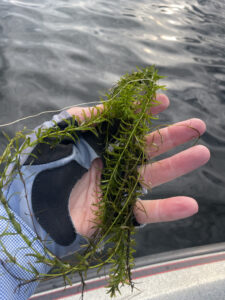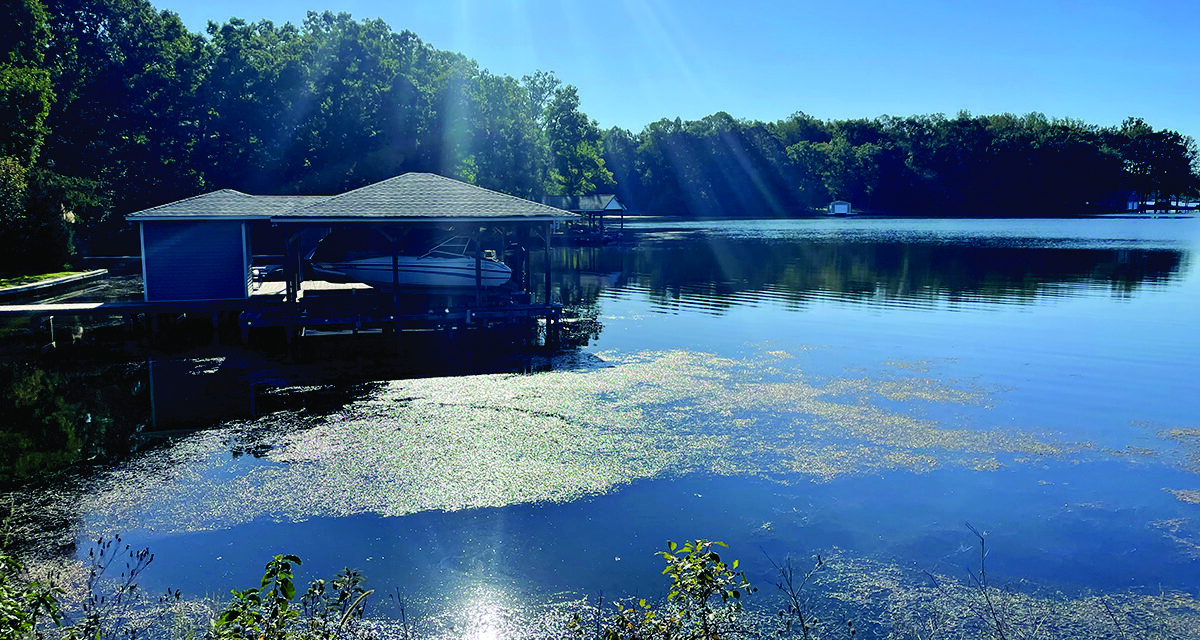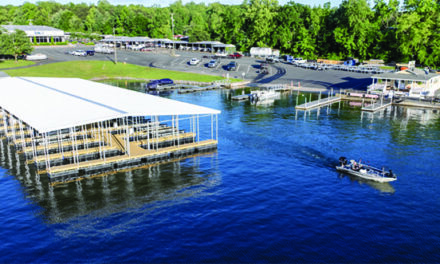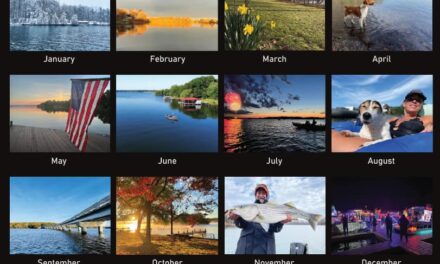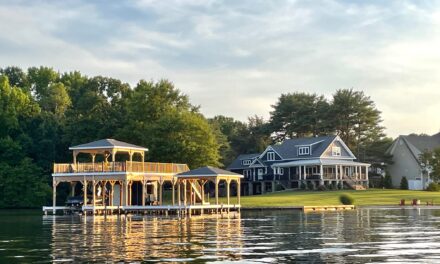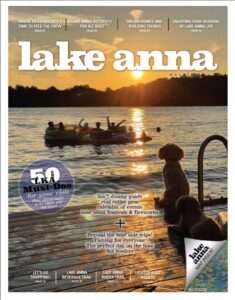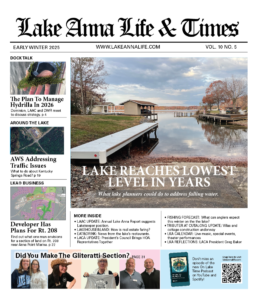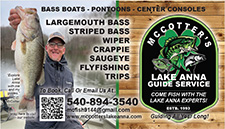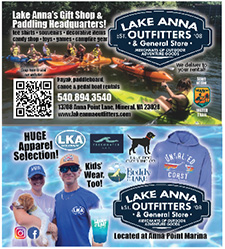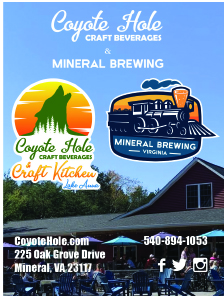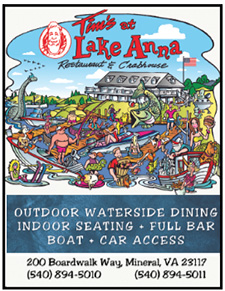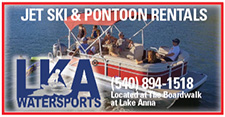BY HARRY LOONEY
Lake Anna is currently facing a significant increase in hydrilla, an invasive aquatic plant, on both the main reservoir (the public side) and in the Waste Heat Treatment Facility (WHTF), also known as the private side. This rapid expansion of growth is a top priority for local organizations and residents who are working to manage it and keep the lake healthy.
To tackle the problem, lake planners and managers will use a two-pronged approach.
Dominion Energy will handle all hydrilla treatment requests for the private side of the lake and the Lake Anna Advisory Committee (LAAC) will handle public side mangement.
As noted above, Dominion Energy will handle all hydrilla mitigation requests for the WHTF. This allows for a more focused and efficient process in the WHTF. Homeowners on the private side dealing with hydrilla should work directly with Dominion to submit a treatment request. This process is currently underway, and many homeowners are already in communication with them.
Dominion Energy’s policy is to conduct business in an environmentally responsible manner that protects North Anna Power Station operations, public health, ecological health, and the recreational use of Lake Anna Reservoir (public) and the WHTF (private) while supporting the restoration of native aquatic grasses and mitigation of invasive grasses such as hydrilla.
As noted in Dominion Energy’s Lake Anna Reservoir and WHTF Vegetation Management & Herbicide/Pesticide Treatment Policy, property owners on the WHTF requesting approval for hydrilla mitigation efforts should request such approvals by contacting Dominion Energy’s Reservoir Coordinator and External Affairs for more information.
Once a request is submitted, Dominion Energy will review the request and provide a response on if the request is approved and, if so, any parameters associated with the approval. You can reach Dominion’s Reservoir Coordinator, Devan Payne, at devan.m.payne@dominionenergy.com.
Meanwhile, the Lake Anna Advisory Committee (LAAC) is focused on the public side of the lake.
On September 4th, the LAAC held a special meeting and unanimously approved using LAAC reserve funds for additional treatments this year. This decision was based on recent surveys and a thorough review of the areas most impacted by dense hydrilla infestations.
Hydrilla treatment requests for the Lake Anna reservoir (public side) should be forwarded to the LAAC Environmental and Water Quality subcommittee at laac.ewq.subcommittee@gmail.com. LAAC will add the reported area to the hydrilla watch list. Areas on the watch list are surveyed regularly to confirm the type of aquatic plant, the area needing to be treated, and any environmental conditions impacting the treatment area such as other aquatic plants, sensitive habitats, and accessibility issues.
The original LAAC hydrilla treatment plan for 2025 included one area approved for the introduction of sterile carp and five areas approved for herbicide treatments.
LAAC introduced 100 sterile carp in the upper reaches of the North Anna River in late April to address a severe hydrilla infestation in an environmentally sensitive area of the lake.
This original herbicide treatment plan was based on a total hydrilla management budget of $25,000. The LAAC did not receive all funding that we requested for calendar year 2025 so the hydrilla budget was reduced to $12,000 in May 2025. The reduced budget allowed the treatment of the highest priority area, Plentiful Creek, in August.
LAAC has now released reserve funding to treat two additional priority areas on the public side of the lake. These areas had previously been approved for treatment but lacked sufficient budget. LACA is moving forward to address these urgent needs:
• Louisa County: Up to 35 acres will be treated along the shorelines of the Tara Shores, Tara Woods, and Bear Castle homeowner associations. The treatment will cover depths from the shoreline out to 8-10 feet.
• Spotsylvania County: Up to 5 acres in the back of Rockland Creek will also be treated. This effort will focus on the area around the community docks and individual boathouses, from the shoreline out to depths of 8-10 feet.
If you’re a private homeowner, landowner, or part of a homeowner or property owner association (HOA/POA) and you want to manage hydrilla, here’s a breakdown of the approved process.
HOA/POA Requests
If you are an HOA, POA, or a group of neighbors looking for treatment, you will submit your request directly to the LAAC Subcommittee using a request form included as Attachment 3 of the Hydrilla Protocol.
It’s important to remember that the timing of your submission matters.
• Submitted before August 15th: Area will be surveyed this year, and the request will be included in the planning process for next year’s treatment.
• Submitted after August 16th: Area will be surveyed next year, and request will be considered for the treatment plan in the year after that.
Once approved, all treatments must be performed by a licensed contractor using products approved by the Virginia Department of Wildlife Resources (DWR) and in accordance with state permits. Private treatments will be conducted by LAAC’s currently contracted licensed applicator. HOAs/POAs are responsible establishing a contract or purchase order with the vendor and for making payment to the vendor. Treatment dates must be coordinated with the LAAC subcommittee at least one week in advance so local officials can be notified. HOA/POA officials are responsible for notifying adjacent landowners.
Private Homeowner/Landowner Requests
If you are a single homeowner or a small group of neighbors requesting a spot treatment of a single dock or private swim area, contact the LAAC subcommittee via email to start the process. Information needed includes a street address for the property, the approximate area that the homeowner desires treatment, and a mobile phone number for future coordination.
The LAAC Subcommittee will add the area to the hydrilla watch list and will survey the requested treatment area. The LAAC will then refer your request to Dominion Energy for their review. Dominion will decide if they will process the request or ask LAAC to put it through LAAC’s hydrilla protocol request process. Once Dominion has a decision, the LAAC will inform the requestor on who will process the request.
All treatments must follow the same state permit and contractor requirements as HOA/POA requests. As with the HOA/POA process, you are responsible for hiring the licensed contractor, the cost, coordinating with the LAAC, and for notifying your neighbors.
The LAAC’s hydrilla protocol is an adaptable plan, designed to be a living document that can be adjusted based on changing conditions. LAAC’s goal is to make all decisions with clear, data-driven insights and a strong focus on fiscal responsibility. By following these guidelines, LAAC strives to ensure that every treatment is effective and that community’s resources are used wisely to keep Lake Anna healthy for everyone.
“These new efforts demonstrate a strong commitment to addressing the spread of hydrilla, maintaining a sound ecological balance at the lake and preserving the recreational use of Lake Anna for everyone. By collaborating and funding these specifically targeted treatments, we are taking a significant step in our ongoing effort to protect this lake. We’ll also be evaluating the protocol’s effectiveness this winter,” noted LAAC Chairman C.C. McCotter.
Hydrilla Management: Grass Carp Vs. Aquatic Herbicide
BY JOHN ODENKIRK, DWR BIOLOGIST
This answer to the question of how best to manage hydrilla is not as simple as one might expect. First, reservoir ownership, primary uses, water quality, and other factors must be considered.
Many aquatic ecologists and biologists consider vegetation coverage of 20 to 30% optimal; however, this density may be unacceptable to some lake users (Lake Anna is currently at about 2%). Thus, there may be a need to “control” aquatic vegetation at lower levels, without its elimination, to maintain benefits such as fisheries habitat and harmful algal bloom (HAB) reduction.
Biological control (e.g., grass carp) and chemical control (herbicides) are two common methods to control aquatic vegetation.
Benefits of carp include ease of use and minimal expense. However, carp often swim out of stocking locations, consume non-target plants, and are notorious for outmigration, completely vacating stocked waters.
Large-scale grass carp stockings have been implicated in elimination of all submersed aquatic vegetation (SAV) as happened at Lake Anna in the early 1990s. Elimination and/or severe reduction of SAV can reroute nutrient flow (especially phosphorus) to undesirable algal production fueling HAB outbreaks and resulting in water contact advisories.
Herbicides approved by EPA for aquatic use applied by VDACS-permitted applicators have proven safe and effective, but benefits are seasonal; and costs can be significant. However, new systemic herbicides may offer longer term benefits, have fewer use restrictions, and are now under consideration for use at Anna.
So, the answer to the original question posed above is likely “both”!
Integrated pest management (IPM) is often the best approach. IPM combines multiple techniques and has been used at Lake Anna for about a decade. Limited grass carp stockings combined with targeted herbicide treatments can facilitate reduction of overall plant density while focusing on trouble areas including boating access, swimming beaches, etc.
The current aquatic vegetation complex at Lake Anna including SAV (hydrilla, native naiad, etc.), emergent vegetation (e.g., water willow) and beneficial phytoplankton is driving a world-class fishery with metrics of game fish abundance and size at all-time highs.
The fuel of this rejuvenation is habitat, of which a large portion is SAV; and its management must be governed by a high degree of caution.
Editor’s Note: Author John Odenkirk is a trained biologist that has worked for the DWR for nearly 35 years. He has overseen the manament of Lake Anna for over 25 years.
Identifying Lake Anna’s Different Aquatic Vegetation
Lake Anna is no different from most lakes in the region in that it harbors native submerged aquatic vegetation (SAV) and from time to time, non-native SAV like hydrilla. Being able to identify common plants at Lake Anna is part of being a responsible resident of the community. Understanding the differences and dynamics of each leads to comprehension of the lake’s ecology – another part of Lake Anna life.
The three most common types of vegetation in the lake are southern naiad, hydrilla and water willow.
The latter is a native emergent vegetation that lays dormant throughout the winter along the shoreline of the lake – looking a lot like straw in the water. By the end of April, it begins to sprout green shoots and by the end of May it’s lush. Water willow produce outstanding littoral zone (shallow water) habitat for all things lake including fish, frogs, herons, insects, invertebrates, crawfish and much more. Water willow grows via runners along the bottom and is very hardy.
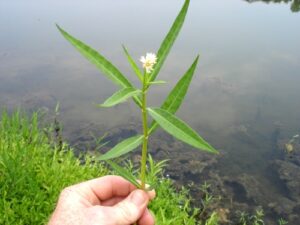
Southern naiad is SAV and grows up from the lake bottom toward the surface. It rarely mats. It is considered native to most of the contiguous United States. It produces a slender, branching stem up to 60 to 90 centimeters in maximum length. The thin, green, somewhat transparent, flexible leaves are up to three centimeters long and just one or two millimeters wide. They are edged with minute, unicellular teeth. Ducks love to eat southern naiad and it harbors many invertebrates and juvenile fish.
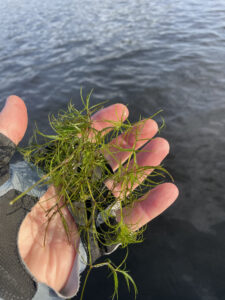
Hydrilla is native to the cool and warm waters of Asia, Africa and Australia. It was introduced to US waters by the aquarium trade. Stems grow up to one to two meters long. The leaves are arranged in whorls of two to eight around the stem, each leaf 5–20 millimeters long and 0.7–2 millimeters broad, with serrations or small spines along the leaf margins. Hydrilla reproduces primarily by fragmentation and by rhizomes and turions (overwintering). Hydrilla can grow up to an inch a day, producing dense mats of vegetation along the bottom of lakes and rivers. Healthy hydrilla ranges from bright green to dark green.
